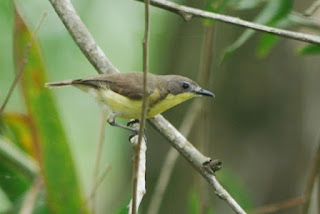Japan 19-21May13
From Yamane
19 May
I report you about my birding at my favourite place on 19 May. At last, Japanese Paradise-flycatchers came!
19. May 2013 Hayama/Morito River Upperstream 10:00-15:00
1. Chinese Bamboo Partridge
2. Oriental Turtle Dove
3. Lessor Cockoo
4. Black Kite
5. Japanese Pygmy Woodpecker
6. Japanese Green Woodpecker
7. Japanese Paradise-flycatcher (male)
8. Jungle Crow
9. Varied Tit
10. Japanese Tit
11. Barn swallow
12. Brown-eared Bulbul
13. Japanese Bush Warbler
14. Long-tailed Tit
15. Eastern Crowned Warbler
16. Japanese White-eye
17. Blue-and-white Flycatcher (male)
18. Eurasian Tree Sparrow
19. Japanese Pied Wagtail
20. Meadow Bunting
* Japanese Paradise Flycatches reached here. I could see 1 pair of them. But they didn’t start meking their nest.
* Some Blue-and white Flycatchers seemed to start breeding. But not all. The male in this picture seemed not to find his partner.
20-21 May
I report you of White-bellied Green-pigeon, drinking sea warter. They started drinking around May to Oct. every year.


Left male, right female
Male has yellow breast and dark-red wings. Female is almost light-green breast & olive wings. As they are named, their bellies’ color is whity or cream. Generally they are residents in mountains. They come here for only drinking sea water. Some pigeons stay at the forest near the seashore in the previous night. Others come directly from the mountains, named Tanzawa mountains.
They come some times for drinking in a day, mainly in the morning. Between the drinking times they rest in the near forest.
After their breeding, also their young birds come here with the parents around Jul. It’s dangerous for the pigeons to drink sea water. Also on 21 May, we saw a pigeon that was washed away by waves unfortunately. We don’t understand why they drink sea water. Some persons are researching these behaviors. We know the Pigeons drink sea water at only some places.
Terugasaki, Oiso, Kanagawa
9. May 2013 9:30-12:00
20. May 2013 9:30-11:00
21. May 2013 8:30-11:00
1. White-bellied Green Pigeon
2. Streaked Shearwater
3. Japanese Cormorant
4. Whimbrel
5. Grey-tailed Tattler
6. Common Sandpiper
7. Black-tailed Gull
8. Black Kite (harassed by crow)
9. Jungle Crow
10. Barn swallow (In the building of Oiso train station.)
11. Common House Martin (We can see the many nests of Common House Martins near place.)
12. Brown-eared Bulbul
13. Eurasian Tree Sparrow
14. Japanese Pied Wagtail



























